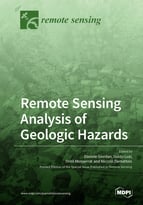Remote Sensing Analysis of Geologic Hazards
A special issue of Remote Sensing (ISSN 2072-4292). This special issue belongs to the section "Remote Sensing in Geology, Geomorphology and Hydrology".
Deadline for manuscript submissions: closed (15 April 2022) | Viewed by 34382
Special Issue Editors
Interests: unmanned aerial vehicles; natural hazards; engineering geology
Special Issues, Collections and Topics in MDPI journals
Interests: remotes sensing; SAR interferometry; microwave radiometry; geophysics
Special Issues, Collections and Topics in MDPI journals
Interests: remote sensing data processing; SAR data; SAR interferometry; geohazards monitoring; landslide mapping; building monitoring; land subsidence
Special Issues, Collections and Topics in MDPI journals
Interests: boundary layer meteorology; image processing; MATLAB; earth observation; deformation monitoring; remote sensing; data integration; glaciology; digital image correlation and tracking; advanced machine learning
Special Issues, Collections and Topics in MDPI journals
Special Issue Information
Dear Colleagues,
In recent decades, classical survey techniques (i.e., field measurements and aerial remote sensing) have evolved and with the advent of new technologies and platforms (e.g., terrestrial radar interferometry, UAV, digital time-lapse cameras, laser scanners), remote sensing systems became popular and widely used in geosciences.
Contactless devices are not invasive and allow measuring without access to the investigated area. This is an excellent advantage as earth surface processes often occur in remote areas and can be potentially dangerous or accessible with difficulty. Satellite and aerial remote sensing offers the possibility of using multi-band high-resolution images over large areas. While ground-based surveys usually have high-acquisition frequency compared to satellite systems and they are often able to observe the evolution of fast processes and their possible paroxysmal phase (e.g., volcanic eruptions, glaciers instabilities, landslides, floods). For their characteristics, proximal remote sensing applications are often used in high-frequency monitoring activities, as they can provide real-time or near-real-time information. Therefore, they can be of great support for early warning procedures and risk assessment and management. Combined with aerospace platforms, terrestrial contactless devices are particularly suitable for data integration techniques and multi-scale approaches.
In this Special Issue, we invite contributions focused on recent and upcoming advances in remote sensing applications in earth sciences. In particular, this Special Issue is dedicated to satellite, aerial and terrestrial contactless devices for monitoring, warning and risk and damage assessment, and new processing techniques and data integration approaches. Contributions presenting exemplar case studies of innovative uses of remote sensing will be welcome as well.
Specific contexts where remote sensing applications include but are not limited to the following:
- Landslides;
- Glacier dynamics and instabilities;
- Debris flows;
- Volcano eruptions;
- Earthquakes;
- River flows and floods;
- Rock glaciers and periglacial processes;
- Snow and ice avalanches.
Dr. Daniele Giordan
Dr. Guido Luzi
Dr. Oriol Monserrat
Dr. Niccolò Dematteis
Guest Editors
Manuscript Submission Information
Manuscripts should be submitted online at www.mdpi.com by registering and logging in to this website. Once you are registered, click here to go to the submission form. Manuscripts can be submitted until the deadline. All submissions that pass pre-check are peer-reviewed. Accepted papers will be published continuously in the journal (as soon as accepted) and will be listed together on the special issue website. Research articles, review articles as well as short communications are invited. For planned papers, a title and short abstract (about 100 words) can be sent to the Editorial Office for announcement on this website.
Submitted manuscripts should not have been published previously, nor be under consideration for publication elsewhere (except conference proceedings papers). All manuscripts are thoroughly refereed through a single-blind peer-review process. A guide for authors and other relevant information for submission of manuscripts is available on the Instructions for Authors page. Remote Sensing is an international peer-reviewed open access semimonthly journal published by MDPI.
Please visit the Instructions for Authors page before submitting a manuscript. The Article Processing Charge (APC) for publication in this open access journal is 2700 CHF (Swiss Francs). Submitted papers should be well formatted and use good English. Authors may use MDPI's English editing service prior to publication or during author revisions.
Keywords
- Remote sensing
- Landslides
- Glacier dynamics and instabilities
- Debris flows
- Volcano eruptions
- Earthquakes
- River flows and floods
- Rock glaciers and periglacial processes
- Snow and ice avalanches









